Managing Employee Behavior: Challenges and Strategies in Organizations
VerifiedAdded on 2020/05/11
|9
|2156
|130
Essay
AI Summary
The essay provides an insightful analysis of managing employee behavior within organizations, emphasizing both its advantages and disadvantages. Managers face significant challenges including handling culturally diverse workforces and addressing employee grievances to maintain productivity levels. Key management strategies discussed include effective communication, comprehensive employee training, fostering team collaboration, acknowledging cultural diversity, prioritizing customer satisfaction, and promoting workplace civility. The paper underscores the importance of proactive management in enhancing organizational effectiveness through positive employee behavior.
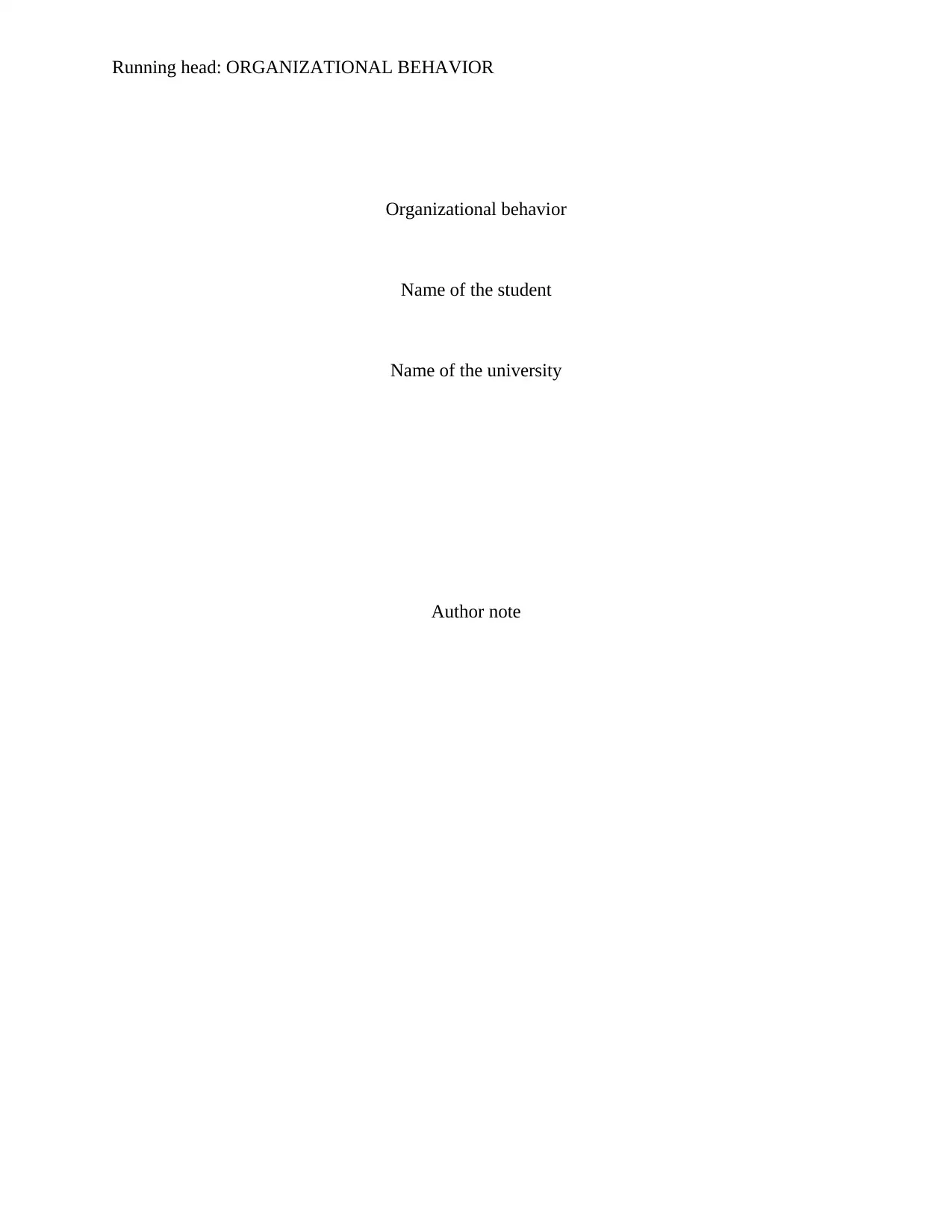
Running head: ORGANIZATIONAL BEHAVIOR
Organizational behavior
Name of the student
Name of the university
Author note
Organizational behavior
Name of the student
Name of the university
Author note
Paraphrase This Document
Need a fresh take? Get an instant paraphrase of this document with our AI Paraphraser
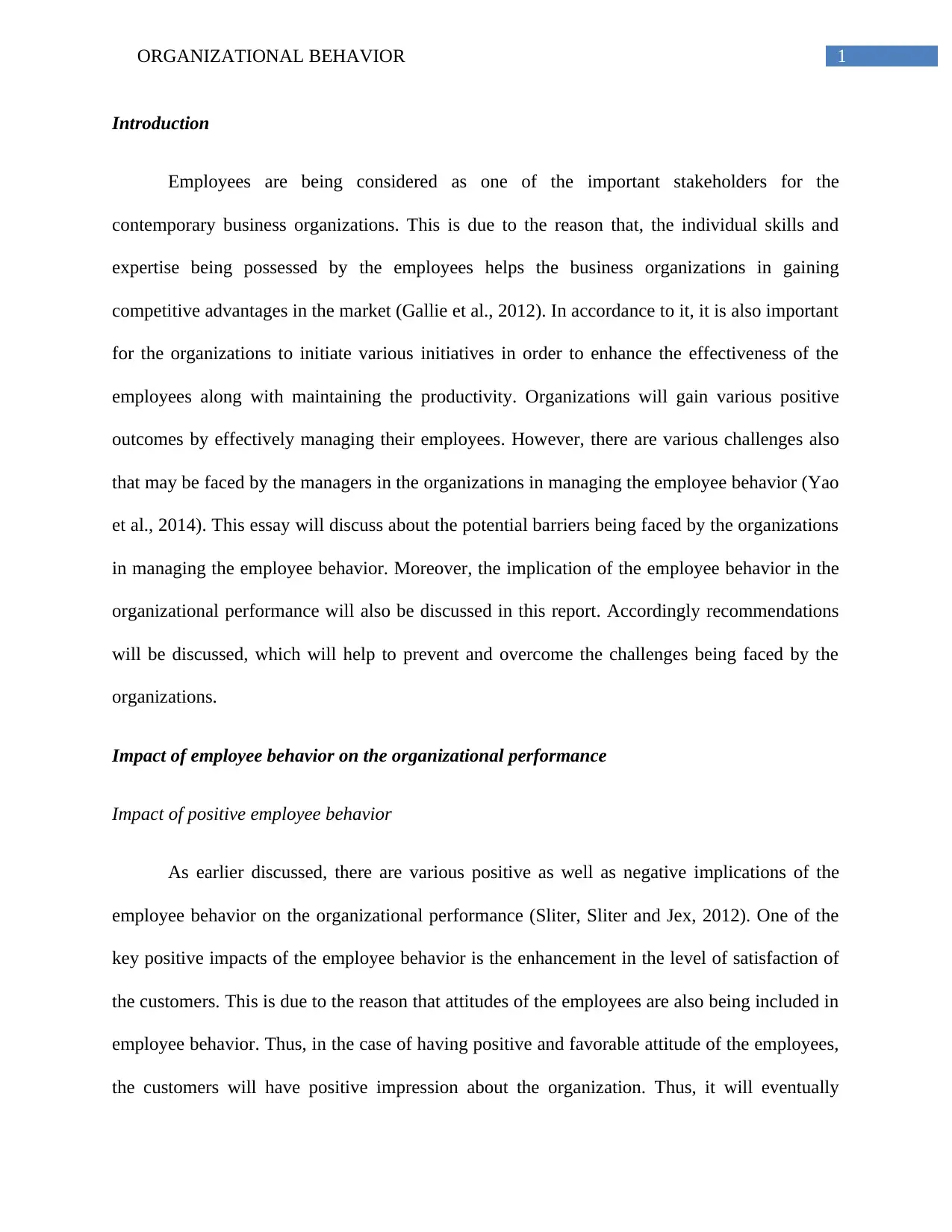
1ORGANIZATIONAL BEHAVIOR
Introduction
Employees are being considered as one of the important stakeholders for the
contemporary business organizations. This is due to the reason that, the individual skills and
expertise being possessed by the employees helps the business organizations in gaining
competitive advantages in the market (Gallie et al., 2012). In accordance to it, it is also important
for the organizations to initiate various initiatives in order to enhance the effectiveness of the
employees along with maintaining the productivity. Organizations will gain various positive
outcomes by effectively managing their employees. However, there are various challenges also
that may be faced by the managers in the organizations in managing the employee behavior (Yao
et al., 2014). This essay will discuss about the potential barriers being faced by the organizations
in managing the employee behavior. Moreover, the implication of the employee behavior in the
organizational performance will also be discussed in this report. Accordingly recommendations
will be discussed, which will help to prevent and overcome the challenges being faced by the
organizations.
Impact of employee behavior on the organizational performance
Impact of positive employee behavior
As earlier discussed, there are various positive as well as negative implications of the
employee behavior on the organizational performance (Sliter, Sliter and Jex, 2012). One of the
key positive impacts of the employee behavior is the enhancement in the level of satisfaction of
the customers. This is due to the reason that attitudes of the employees are also being included in
employee behavior. Thus, in the case of having positive and favorable attitude of the employees,
the customers will have positive impression about the organization. Thus, it will eventually
Introduction
Employees are being considered as one of the important stakeholders for the
contemporary business organizations. This is due to the reason that, the individual skills and
expertise being possessed by the employees helps the business organizations in gaining
competitive advantages in the market (Gallie et al., 2012). In accordance to it, it is also important
for the organizations to initiate various initiatives in order to enhance the effectiveness of the
employees along with maintaining the productivity. Organizations will gain various positive
outcomes by effectively managing their employees. However, there are various challenges also
that may be faced by the managers in the organizations in managing the employee behavior (Yao
et al., 2014). This essay will discuss about the potential barriers being faced by the organizations
in managing the employee behavior. Moreover, the implication of the employee behavior in the
organizational performance will also be discussed in this report. Accordingly recommendations
will be discussed, which will help to prevent and overcome the challenges being faced by the
organizations.
Impact of employee behavior on the organizational performance
Impact of positive employee behavior
As earlier discussed, there are various positive as well as negative implications of the
employee behavior on the organizational performance (Sliter, Sliter and Jex, 2012). One of the
key positive impacts of the employee behavior is the enhancement in the level of satisfaction of
the customers. This is due to the reason that attitudes of the employees are also being included in
employee behavior. Thus, in the case of having positive and favorable attitude of the employees,
the customers will have positive impression about the organization. Thus, it will eventually
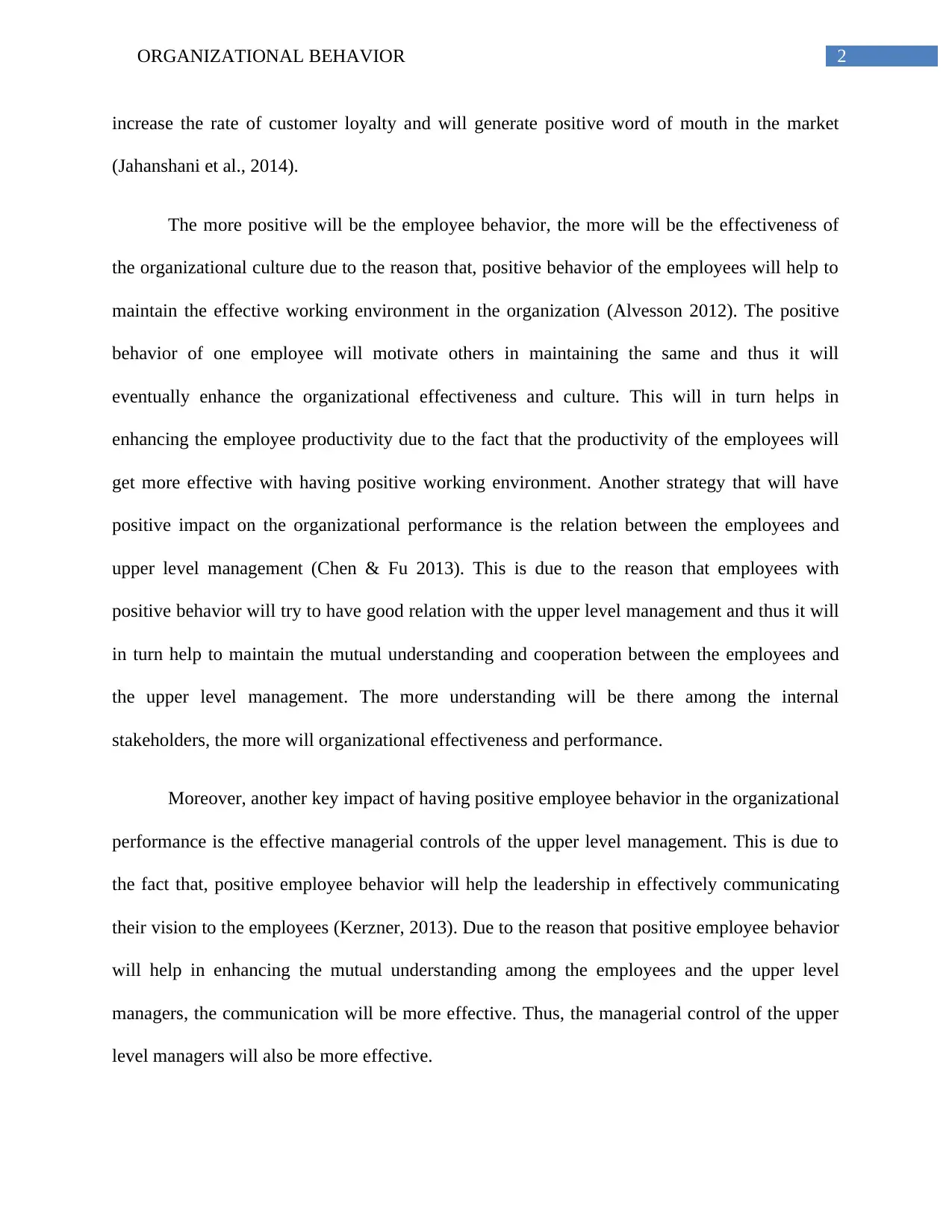
2ORGANIZATIONAL BEHAVIOR
increase the rate of customer loyalty and will generate positive word of mouth in the market
(Jahanshani et al., 2014).
The more positive will be the employee behavior, the more will be the effectiveness of
the organizational culture due to the reason that, positive behavior of the employees will help to
maintain the effective working environment in the organization (Alvesson 2012). The positive
behavior of one employee will motivate others in maintaining the same and thus it will
eventually enhance the organizational effectiveness and culture. This will in turn helps in
enhancing the employee productivity due to the fact that the productivity of the employees will
get more effective with having positive working environment. Another strategy that will have
positive impact on the organizational performance is the relation between the employees and
upper level management (Chen & Fu 2013). This is due to the reason that employees with
positive behavior will try to have good relation with the upper level management and thus it will
in turn help to maintain the mutual understanding and cooperation between the employees and
the upper level management. The more understanding will be there among the internal
stakeholders, the more will organizational effectiveness and performance.
Moreover, another key impact of having positive employee behavior in the organizational
performance is the effective managerial controls of the upper level management. This is due to
the fact that, positive employee behavior will help the leadership in effectively communicating
their vision to the employees (Kerzner, 2013). Due to the reason that positive employee behavior
will help in enhancing the mutual understanding among the employees and the upper level
managers, the communication will be more effective. Thus, the managerial control of the upper
level managers will also be more effective.
increase the rate of customer loyalty and will generate positive word of mouth in the market
(Jahanshani et al., 2014).
The more positive will be the employee behavior, the more will be the effectiveness of
the organizational culture due to the reason that, positive behavior of the employees will help to
maintain the effective working environment in the organization (Alvesson 2012). The positive
behavior of one employee will motivate others in maintaining the same and thus it will
eventually enhance the organizational effectiveness and culture. This will in turn helps in
enhancing the employee productivity due to the fact that the productivity of the employees will
get more effective with having positive working environment. Another strategy that will have
positive impact on the organizational performance is the relation between the employees and
upper level management (Chen & Fu 2013). This is due to the reason that employees with
positive behavior will try to have good relation with the upper level management and thus it will
in turn help to maintain the mutual understanding and cooperation between the employees and
the upper level management. The more understanding will be there among the internal
stakeholders, the more will organizational effectiveness and performance.
Moreover, another key impact of having positive employee behavior in the organizational
performance is the effective managerial controls of the upper level management. This is due to
the fact that, positive employee behavior will help the leadership in effectively communicating
their vision to the employees (Kerzner, 2013). Due to the reason that positive employee behavior
will help in enhancing the mutual understanding among the employees and the upper level
managers, the communication will be more effective. Thus, the managerial control of the upper
level managers will also be more effective.
⊘ This is a preview!⊘
Do you want full access?
Subscribe today to unlock all pages.

Trusted by 1+ million students worldwide
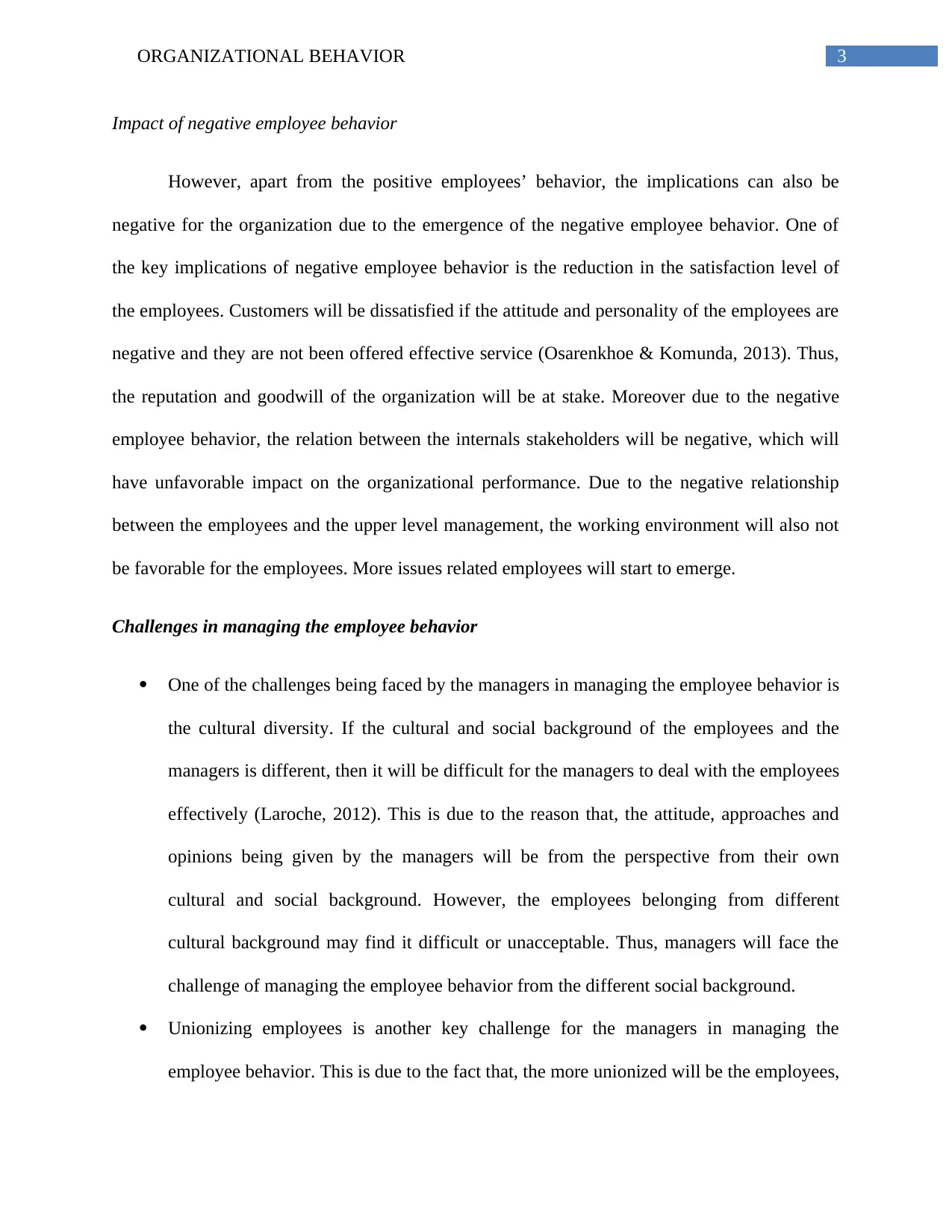
3ORGANIZATIONAL BEHAVIOR
Impact of negative employee behavior
However, apart from the positive employees’ behavior, the implications can also be
negative for the organization due to the emergence of the negative employee behavior. One of
the key implications of negative employee behavior is the reduction in the satisfaction level of
the employees. Customers will be dissatisfied if the attitude and personality of the employees are
negative and they are not been offered effective service (Osarenkhoe & Komunda, 2013). Thus,
the reputation and goodwill of the organization will be at stake. Moreover due to the negative
employee behavior, the relation between the internals stakeholders will be negative, which will
have unfavorable impact on the organizational performance. Due to the negative relationship
between the employees and the upper level management, the working environment will also not
be favorable for the employees. More issues related employees will start to emerge.
Challenges in managing the employee behavior
One of the challenges being faced by the managers in managing the employee behavior is
the cultural diversity. If the cultural and social background of the employees and the
managers is different, then it will be difficult for the managers to deal with the employees
effectively (Laroche, 2012). This is due to the reason that, the attitude, approaches and
opinions being given by the managers will be from the perspective from their own
cultural and social background. However, the employees belonging from different
cultural background may find it difficult or unacceptable. Thus, managers will face the
challenge of managing the employee behavior from the different social background.
Unionizing employees is another key challenge for the managers in managing the
employee behavior. This is due to the fact that, the more unionized will be the employees,
Impact of negative employee behavior
However, apart from the positive employees’ behavior, the implications can also be
negative for the organization due to the emergence of the negative employee behavior. One of
the key implications of negative employee behavior is the reduction in the satisfaction level of
the employees. Customers will be dissatisfied if the attitude and personality of the employees are
negative and they are not been offered effective service (Osarenkhoe & Komunda, 2013). Thus,
the reputation and goodwill of the organization will be at stake. Moreover due to the negative
employee behavior, the relation between the internals stakeholders will be negative, which will
have unfavorable impact on the organizational performance. Due to the negative relationship
between the employees and the upper level management, the working environment will also not
be favorable for the employees. More issues related employees will start to emerge.
Challenges in managing the employee behavior
One of the challenges being faced by the managers in managing the employee behavior is
the cultural diversity. If the cultural and social background of the employees and the
managers is different, then it will be difficult for the managers to deal with the employees
effectively (Laroche, 2012). This is due to the reason that, the attitude, approaches and
opinions being given by the managers will be from the perspective from their own
cultural and social background. However, the employees belonging from different
cultural background may find it difficult or unacceptable. Thus, managers will face the
challenge of managing the employee behavior from the different social background.
Unionizing employees is another key challenge for the managers in managing the
employee behavior. This is due to the fact that, the more unionized will be the employees,
Paraphrase This Document
Need a fresh take? Get an instant paraphrase of this document with our AI Paraphraser
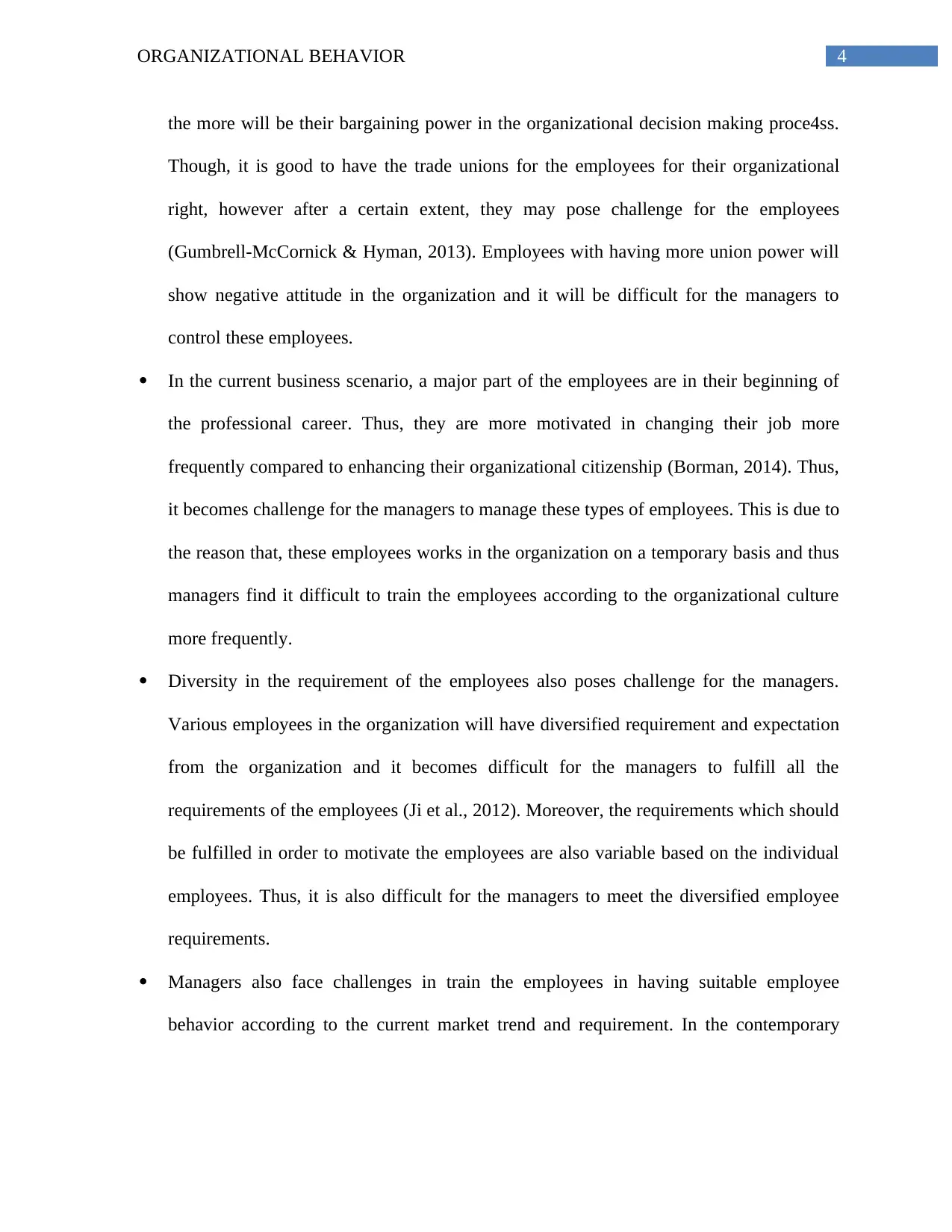
4ORGANIZATIONAL BEHAVIOR
the more will be their bargaining power in the organizational decision making proce4ss.
Though, it is good to have the trade unions for the employees for their organizational
right, however after a certain extent, they may pose challenge for the employees
(Gumbrell-McCornick & Hyman, 2013). Employees with having more union power will
show negative attitude in the organization and it will be difficult for the managers to
control these employees.
In the current business scenario, a major part of the employees are in their beginning of
the professional career. Thus, they are more motivated in changing their job more
frequently compared to enhancing their organizational citizenship (Borman, 2014). Thus,
it becomes challenge for the managers to manage these types of employees. This is due to
the reason that, these employees works in the organization on a temporary basis and thus
managers find it difficult to train the employees according to the organizational culture
more frequently.
Diversity in the requirement of the employees also poses challenge for the managers.
Various employees in the organization will have diversified requirement and expectation
from the organization and it becomes difficult for the managers to fulfill all the
requirements of the employees (Ji et al., 2012). Moreover, the requirements which should
be fulfilled in order to motivate the employees are also variable based on the individual
employees. Thus, it is also difficult for the managers to meet the diversified employee
requirements.
Managers also face challenges in train the employees in having suitable employee
behavior according to the current market trend and requirement. In the contemporary
the more will be their bargaining power in the organizational decision making proce4ss.
Though, it is good to have the trade unions for the employees for their organizational
right, however after a certain extent, they may pose challenge for the employees
(Gumbrell-McCornick & Hyman, 2013). Employees with having more union power will
show negative attitude in the organization and it will be difficult for the managers to
control these employees.
In the current business scenario, a major part of the employees are in their beginning of
the professional career. Thus, they are more motivated in changing their job more
frequently compared to enhancing their organizational citizenship (Borman, 2014). Thus,
it becomes challenge for the managers to manage these types of employees. This is due to
the reason that, these employees works in the organization on a temporary basis and thus
managers find it difficult to train the employees according to the organizational culture
more frequently.
Diversity in the requirement of the employees also poses challenge for the managers.
Various employees in the organization will have diversified requirement and expectation
from the organization and it becomes difficult for the managers to fulfill all the
requirements of the employees (Ji et al., 2012). Moreover, the requirements which should
be fulfilled in order to motivate the employees are also variable based on the individual
employees. Thus, it is also difficult for the managers to meet the diversified employee
requirements.
Managers also face challenges in train the employees in having suitable employee
behavior according to the current market trend and requirement. In the contemporary
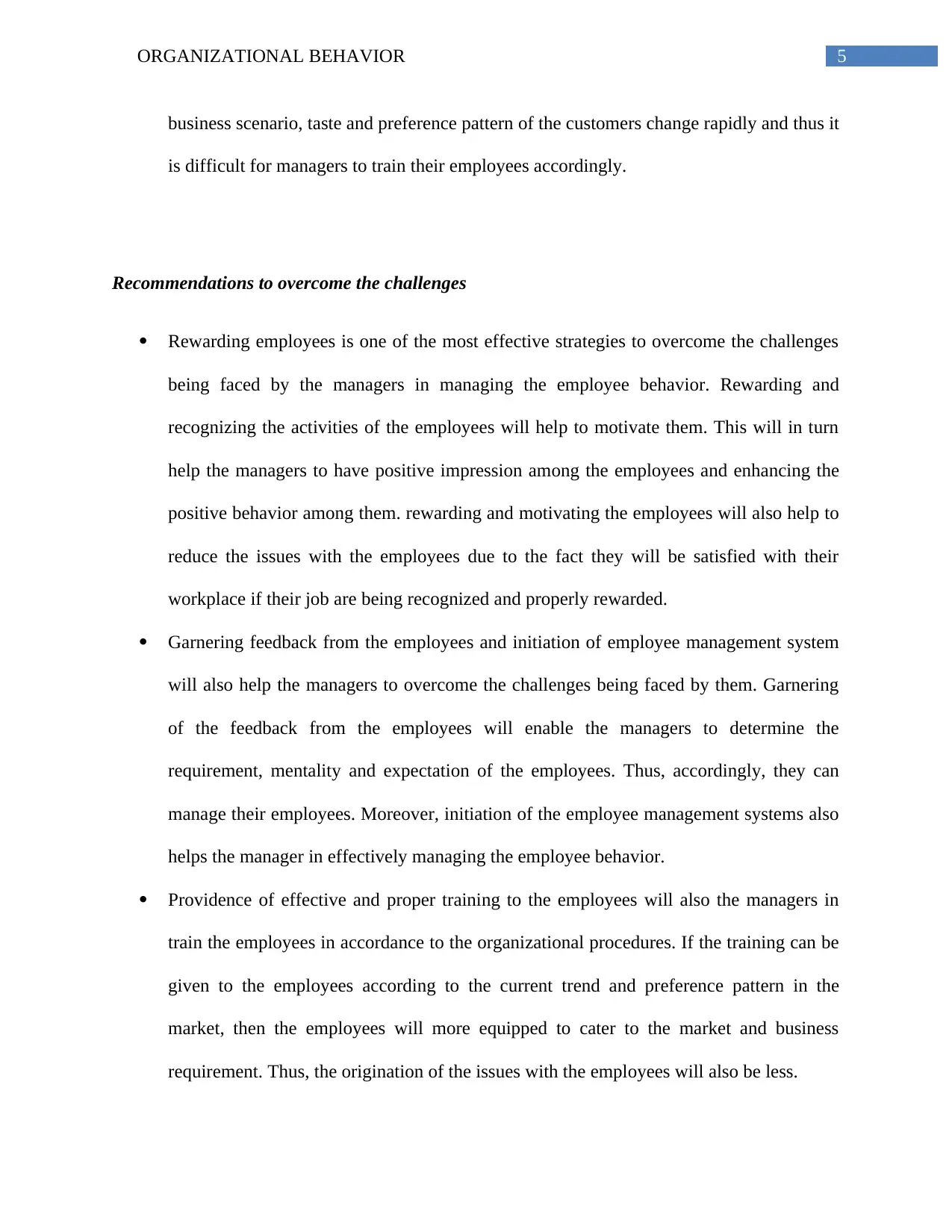
5ORGANIZATIONAL BEHAVIOR
business scenario, taste and preference pattern of the customers change rapidly and thus it
is difficult for managers to train their employees accordingly.
Recommendations to overcome the challenges
Rewarding employees is one of the most effective strategies to overcome the challenges
being faced by the managers in managing the employee behavior. Rewarding and
recognizing the activities of the employees will help to motivate them. This will in turn
help the managers to have positive impression among the employees and enhancing the
positive behavior among them. rewarding and motivating the employees will also help to
reduce the issues with the employees due to the fact they will be satisfied with their
workplace if their job are being recognized and properly rewarded.
Garnering feedback from the employees and initiation of employee management system
will also help the managers to overcome the challenges being faced by them. Garnering
of the feedback from the employees will enable the managers to determine the
requirement, mentality and expectation of the employees. Thus, accordingly, they can
manage their employees. Moreover, initiation of the employee management systems also
helps the manager in effectively managing the employee behavior.
Providence of effective and proper training to the employees will also the managers in
train the employees in accordance to the organizational procedures. If the training can be
given to the employees according to the current trend and preference pattern in the
market, then the employees will more equipped to cater to the market and business
requirement. Thus, the origination of the issues with the employees will also be less.
business scenario, taste and preference pattern of the customers change rapidly and thus it
is difficult for managers to train their employees accordingly.
Recommendations to overcome the challenges
Rewarding employees is one of the most effective strategies to overcome the challenges
being faced by the managers in managing the employee behavior. Rewarding and
recognizing the activities of the employees will help to motivate them. This will in turn
help the managers to have positive impression among the employees and enhancing the
positive behavior among them. rewarding and motivating the employees will also help to
reduce the issues with the employees due to the fact they will be satisfied with their
workplace if their job are being recognized and properly rewarded.
Garnering feedback from the employees and initiation of employee management system
will also help the managers to overcome the challenges being faced by them. Garnering
of the feedback from the employees will enable the managers to determine the
requirement, mentality and expectation of the employees. Thus, accordingly, they can
manage their employees. Moreover, initiation of the employee management systems also
helps the manager in effectively managing the employee behavior.
Providence of effective and proper training to the employees will also the managers in
train the employees in accordance to the organizational procedures. If the training can be
given to the employees according to the current trend and preference pattern in the
market, then the employees will more equipped to cater to the market and business
requirement. Thus, the origination of the issues with the employees will also be less.
⊘ This is a preview!⊘
Do you want full access?
Subscribe today to unlock all pages.

Trusted by 1+ million students worldwide
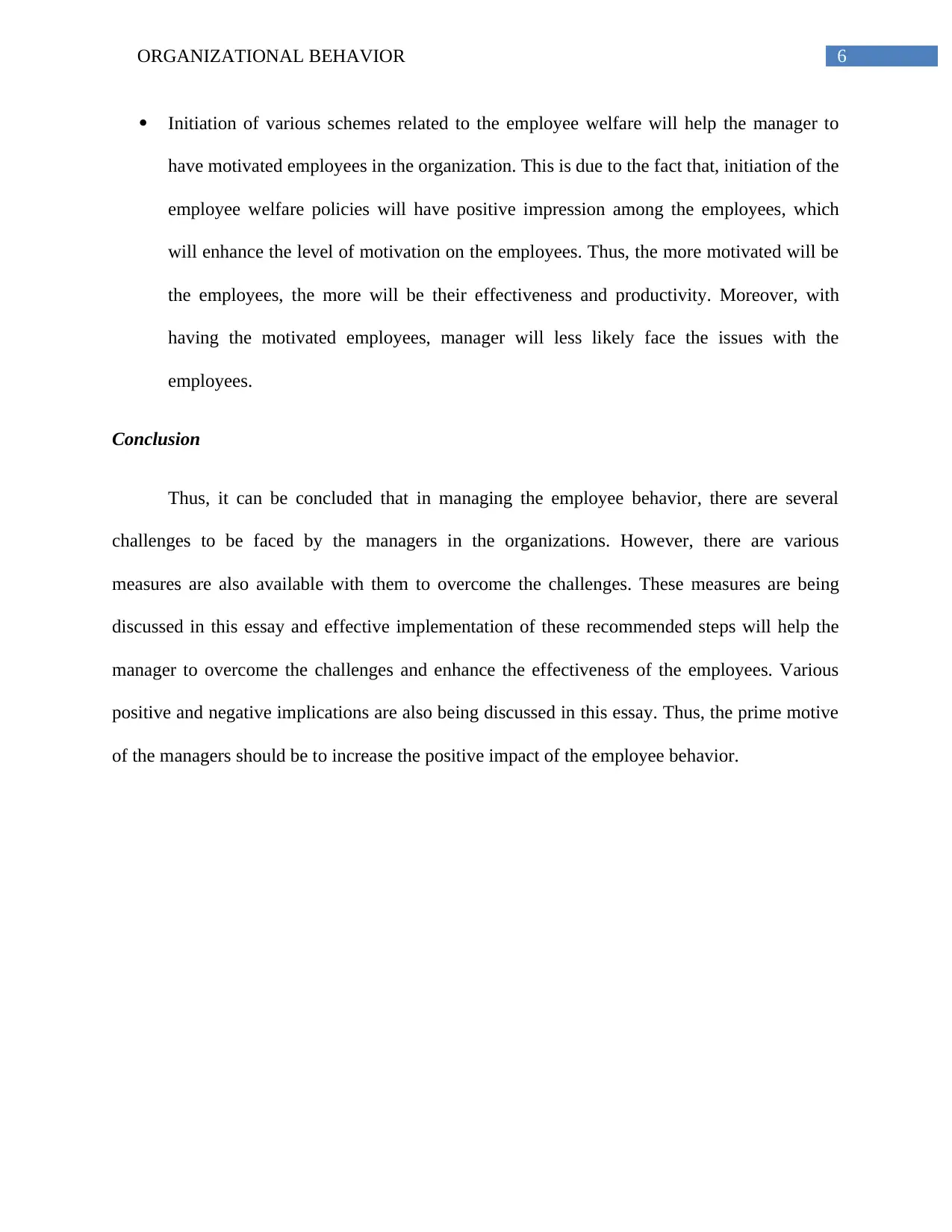
6ORGANIZATIONAL BEHAVIOR
Initiation of various schemes related to the employee welfare will help the manager to
have motivated employees in the organization. This is due to the fact that, initiation of the
employee welfare policies will have positive impression among the employees, which
will enhance the level of motivation on the employees. Thus, the more motivated will be
the employees, the more will be their effectiveness and productivity. Moreover, with
having the motivated employees, manager will less likely face the issues with the
employees.
Conclusion
Thus, it can be concluded that in managing the employee behavior, there are several
challenges to be faced by the managers in the organizations. However, there are various
measures are also available with them to overcome the challenges. These measures are being
discussed in this essay and effective implementation of these recommended steps will help the
manager to overcome the challenges and enhance the effectiveness of the employees. Various
positive and negative implications are also being discussed in this essay. Thus, the prime motive
of the managers should be to increase the positive impact of the employee behavior.
Initiation of various schemes related to the employee welfare will help the manager to
have motivated employees in the organization. This is due to the fact that, initiation of the
employee welfare policies will have positive impression among the employees, which
will enhance the level of motivation on the employees. Thus, the more motivated will be
the employees, the more will be their effectiveness and productivity. Moreover, with
having the motivated employees, manager will less likely face the issues with the
employees.
Conclusion
Thus, it can be concluded that in managing the employee behavior, there are several
challenges to be faced by the managers in the organizations. However, there are various
measures are also available with them to overcome the challenges. These measures are being
discussed in this essay and effective implementation of these recommended steps will help the
manager to overcome the challenges and enhance the effectiveness of the employees. Various
positive and negative implications are also being discussed in this essay. Thus, the prime motive
of the managers should be to increase the positive impact of the employee behavior.
Paraphrase This Document
Need a fresh take? Get an instant paraphrase of this document with our AI Paraphraser
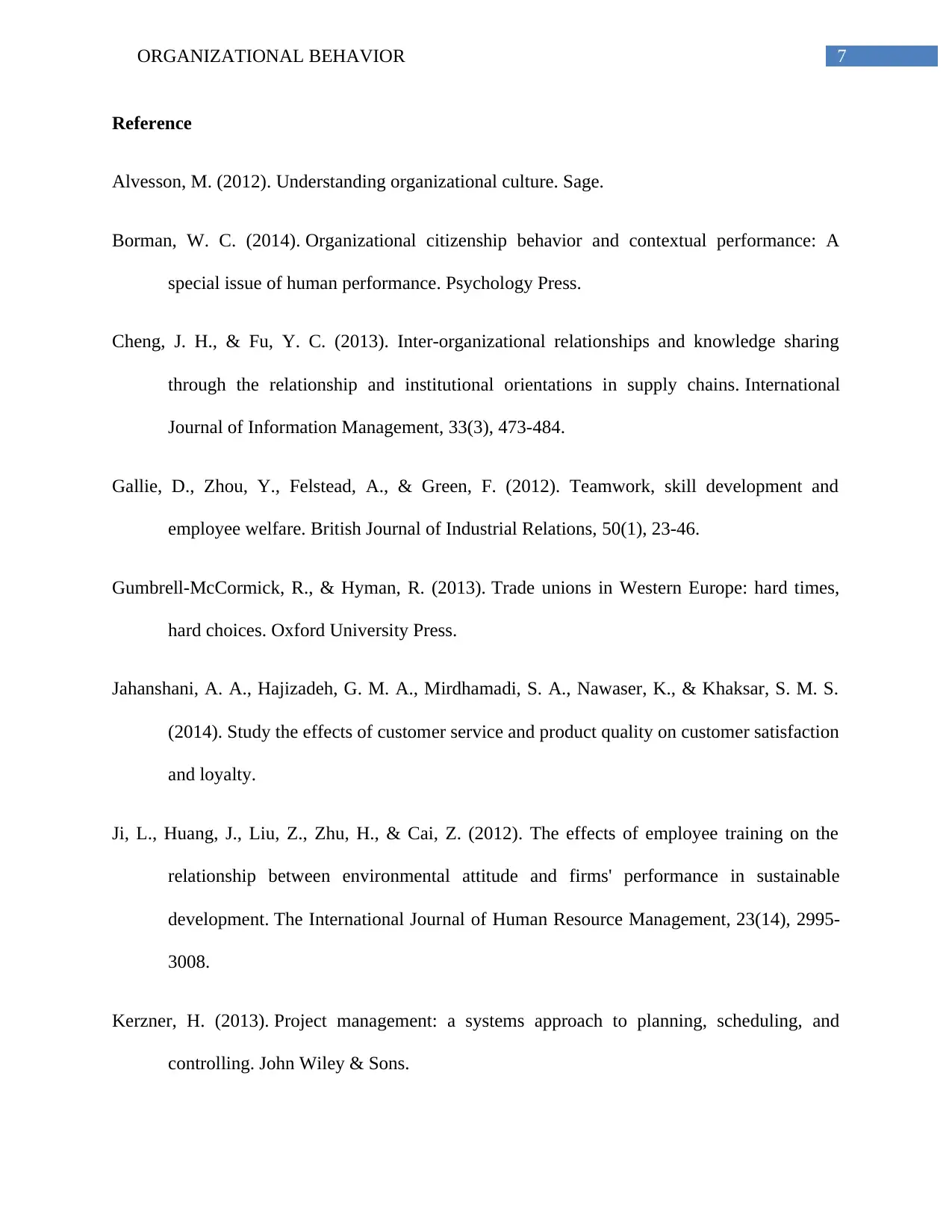
7ORGANIZATIONAL BEHAVIOR
Reference
Alvesson, M. (2012). Understanding organizational culture. Sage.
Borman, W. C. (2014). Organizational citizenship behavior and contextual performance: A
special issue of human performance. Psychology Press.
Cheng, J. H., & Fu, Y. C. (2013). Inter-organizational relationships and knowledge sharing
through the relationship and institutional orientations in supply chains. International
Journal of Information Management, 33(3), 473-484.
Gallie, D., Zhou, Y., Felstead, A., & Green, F. (2012). Teamwork, skill development and
employee welfare. British Journal of Industrial Relations, 50(1), 23-46.
Gumbrell-McCormick, R., & Hyman, R. (2013). Trade unions in Western Europe: hard times,
hard choices. Oxford University Press.
Jahanshani, A. A., Hajizadeh, G. M. A., Mirdhamadi, S. A., Nawaser, K., & Khaksar, S. M. S.
(2014). Study the effects of customer service and product quality on customer satisfaction
and loyalty.
Ji, L., Huang, J., Liu, Z., Zhu, H., & Cai, Z. (2012). The effects of employee training on the
relationship between environmental attitude and firms' performance in sustainable
development. The International Journal of Human Resource Management, 23(14), 2995-
3008.
Kerzner, H. (2013). Project management: a systems approach to planning, scheduling, and
controlling. John Wiley & Sons.
Reference
Alvesson, M. (2012). Understanding organizational culture. Sage.
Borman, W. C. (2014). Organizational citizenship behavior and contextual performance: A
special issue of human performance. Psychology Press.
Cheng, J. H., & Fu, Y. C. (2013). Inter-organizational relationships and knowledge sharing
through the relationship and institutional orientations in supply chains. International
Journal of Information Management, 33(3), 473-484.
Gallie, D., Zhou, Y., Felstead, A., & Green, F. (2012). Teamwork, skill development and
employee welfare. British Journal of Industrial Relations, 50(1), 23-46.
Gumbrell-McCormick, R., & Hyman, R. (2013). Trade unions in Western Europe: hard times,
hard choices. Oxford University Press.
Jahanshani, A. A., Hajizadeh, G. M. A., Mirdhamadi, S. A., Nawaser, K., & Khaksar, S. M. S.
(2014). Study the effects of customer service and product quality on customer satisfaction
and loyalty.
Ji, L., Huang, J., Liu, Z., Zhu, H., & Cai, Z. (2012). The effects of employee training on the
relationship between environmental attitude and firms' performance in sustainable
development. The International Journal of Human Resource Management, 23(14), 2995-
3008.
Kerzner, H. (2013). Project management: a systems approach to planning, scheduling, and
controlling. John Wiley & Sons.
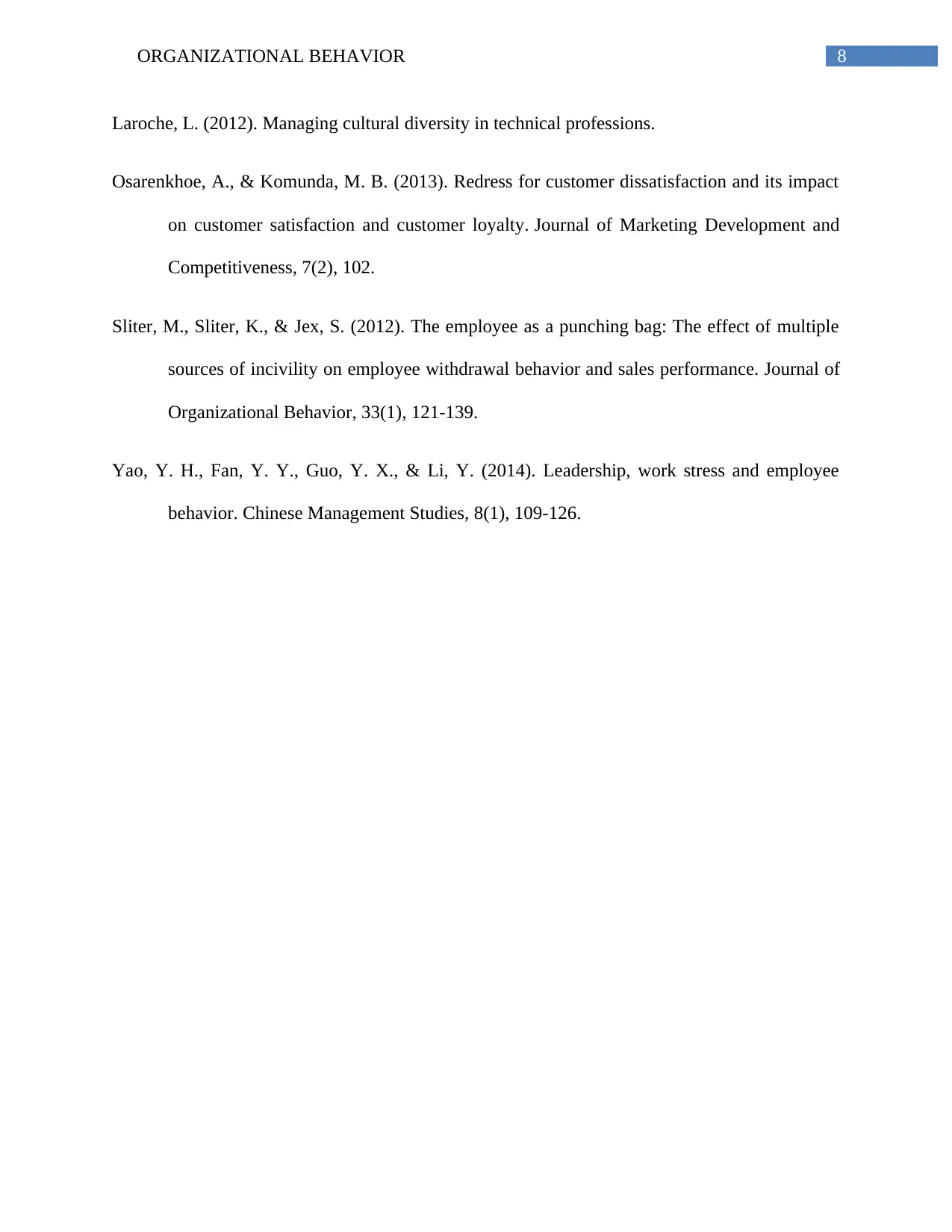
8ORGANIZATIONAL BEHAVIOR
Laroche, L. (2012). Managing cultural diversity in technical professions.
Osarenkhoe, A., & Komunda, M. B. (2013). Redress for customer dissatisfaction and its impact
on customer satisfaction and customer loyalty. Journal of Marketing Development and
Competitiveness, 7(2), 102.
Sliter, M., Sliter, K., & Jex, S. (2012). The employee as a punching bag: The effect of multiple
sources of incivility on employee withdrawal behavior and sales performance. Journal of
Organizational Behavior, 33(1), 121-139.
Yao, Y. H., Fan, Y. Y., Guo, Y. X., & Li, Y. (2014). Leadership, work stress and employee
behavior. Chinese Management Studies, 8(1), 109-126.
Laroche, L. (2012). Managing cultural diversity in technical professions.
Osarenkhoe, A., & Komunda, M. B. (2013). Redress for customer dissatisfaction and its impact
on customer satisfaction and customer loyalty. Journal of Marketing Development and
Competitiveness, 7(2), 102.
Sliter, M., Sliter, K., & Jex, S. (2012). The employee as a punching bag: The effect of multiple
sources of incivility on employee withdrawal behavior and sales performance. Journal of
Organizational Behavior, 33(1), 121-139.
Yao, Y. H., Fan, Y. Y., Guo, Y. X., & Li, Y. (2014). Leadership, work stress and employee
behavior. Chinese Management Studies, 8(1), 109-126.
⊘ This is a preview!⊘
Do you want full access?
Subscribe today to unlock all pages.

Trusted by 1+ million students worldwide
1 out of 9
Related Documents
Your All-in-One AI-Powered Toolkit for Academic Success.
+13062052269
info@desklib.com
Available 24*7 on WhatsApp / Email
![[object Object]](/_next/static/media/star-bottom.7253800d.svg)
Unlock your academic potential
Copyright © 2020–2025 A2Z Services. All Rights Reserved. Developed and managed by ZUCOL.





